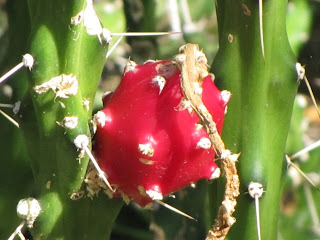A few of the twenty-some species in the genus Harrisia are found in cultivation and often grown as landscape plants in warmer climates where they can clamor and sprawl freely. Stems of this species are typically thin and few-ribbed; areoles with several needle-like spines are spaced enough to make the stems easily visible. All species have large nocturnal, white flowers which are fragrant. Floral tubes have bristles or wool and the fruits are round yellow or red fleshy spheres. The fruits are a useful identification key.
Wild populations of this genus can be found from Florida to California in the United States, through the Caribbean islands and down into South America along the east half of the continent as far south as Argentina. As mentioned above, most species are not well-known in cultivation, presumably because of their unwieldy growth habit. One species H. jusbertii is found in collections and is believed to be an inter-generic hybrid of H. pomanensis and Echinopsis eyriesii. In Florida, this genus is seldom seen in the wild as they inhabit islands and remote places where vegetation is extremely dense and inaccessible. Some will actually crawl and act like vines. I have several pictures from two previous posts showing their blooms on the El Presidio Grounds.
I don't know why I like this plant so much, but it's got a cool feel to it and one of the few cactis to have a vine-like quality.






I have this plant. Mine has red flesh and it is very delicious and nutritious. I saw a photo of this plant in your earlier post. You already have the plant?
ReplyDeleteYes...this one is on the property hanging around a prickly pear cactus. I want to try the fruit...haven't done it yet as the birds get to it before I do.
ReplyDeleteHi Rohrerbot (difficult name to pronounce, hehe), i realized i've been here before. YOur posts especially the one before this is very informative, now i learned a lot to differentiate cacti and euphorbia. Thanks for visiting my post today.
ReplyDelete